If you’re curious about the calorie content of a delicious restaurant cheeseburger, you’ve come to the right place! A cheeseburger can be a tasty treat, but it’s important to be aware of the calories it contains.
The nutrition information for a regular patty cheeseburger with bun is approximately 350 calories, 14g of fat, 630mg of sodium, 35g of carbohydrates, 1.95g of fiber, 6.01g of sugars, and 17g of protein. Different restaurants and brands will have varying calorie counts and nutritional information for their cheeseburgers.
Adding cheese to a burger will increase the saturated fat content, with American cheese, cheddar cheese, pepper jack, blue cheese, Swiss cheese, brie cheese, and part-skim mozzarella cheese having different calorie and fat counts.
Making a cheeseburger at home using leaner meat and being mindful of condiments and toppings can help reduce fat, sodium, and calorie content. Sides like french fries and onion rings can add additional calories, so it’s best to opt for healthier options like fresh fruit or a small salad.
Key Takeaways:
- Calories in a restaurant cheeseburger can vary depending on the ingredients and cooking methods used.
- Adding cheese to a cheeseburger increases the saturated fat content.
- Making a cheeseburger at home allows for more control over the ingredients and can help reduce calorie and fat content.
- Choosing healthier side dish options can help balance out the calorie intake from a cheeseburger.
- Mindful eating and savoring your cheeseburger can enhance your enjoyment and promote a balanced approach to nutrition.
Understanding the Basic Nutrition Facts
Let’s start by delving into the nutrition facts of a typical cheeseburger you’d find at a restaurant. A regular patty cheeseburger with a bun has approximately 350 calories, 14g of fat, 630mg of sodium, 35g of carbohydrates, 1.95g of fiber, 6.01g of sugars, and 17g of protein. These numbers may vary depending on the specific restaurant or brand. It’s important to keep in mind that adding cheese to your burger will increase the saturated fat content.
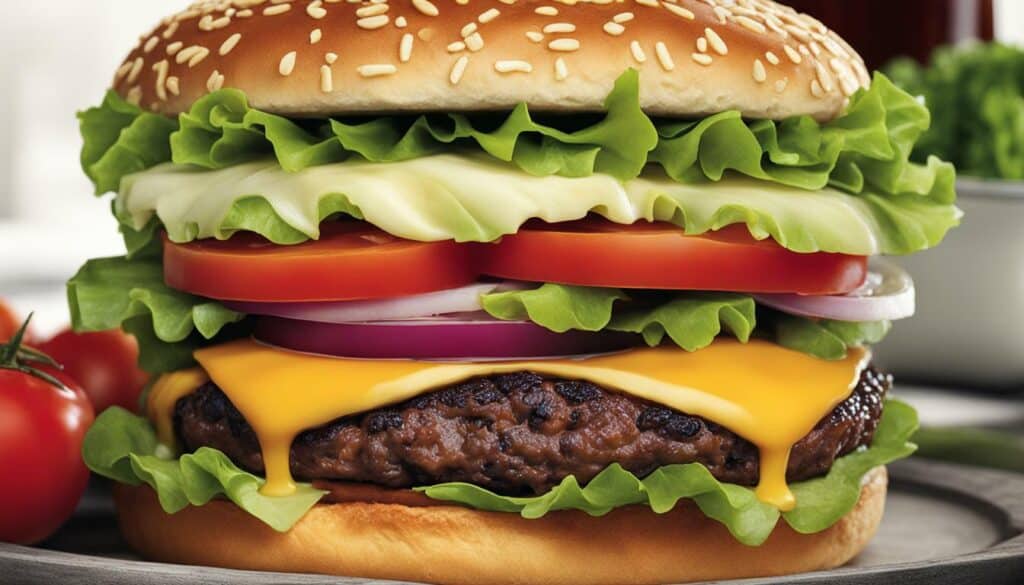
When it comes to cheese options, there are various choices available, each with its own impact on the nutritional value of your cheeseburger. American cheese, cheddar cheese, pepper jack, blue cheese, Swiss cheese, brie cheese, and part-skim mozzarella cheese all have different calorie and fat counts. It’s important to be aware of these differences when making your cheeseburger.
Making a cheeseburger at home can provide more control over the ingredients and allow for healthier options. Opting for leaner meat and being mindful of condiments and toppings can help reduce the fat, sodium, and calorie content of your homemade cheeseburger. Additionally, choosing healthier side dishes like fresh fruit or a small salad instead of high-calorie options like french fries or onion rings can further contribute to a balanced meal.
Understanding the Basic Nutrition Facts: Key Points
- A typical cheeseburger has around 350 calories, 14g of fat, 630mg of sodium, 35g of carbohydrates, 1.95g of fiber, 6.01g of sugars, and 17g of protein.
- Adding cheese to your burger increases the saturated fat content.
- Different cheese options have varying calorie and fat counts.
- Making a cheeseburger at home allows for healthier ingredient choices.
- Opting for healthier sides like fresh fruit or a small salad can balance out the meal.
| Nutrient | Amount per serving |
|---|---|
| Calories | Approximately 350 |
| Fat | 14g |
| Sodium | 630mg |
| Carbohydrates | 35g |
| Fiber | 1.95g |
| Sugars | 6.01g |
| Protein | 17g |
The Standard Cheeseburger: Calorie and Nutrient Breakdown
A regular patty cheeseburger with a bun typically contains around 350 calories and has specific amounts of fat, sodium, carbohydrates, fiber, sugars, and protein. It’s important to be aware of these nutritional components to make informed choices about your meal. Let’s delve deeper into the calorie and nutrient breakdown of a standard cheeseburger.
Here’s an overview of the nutritional information for a regular patty cheeseburger:
| Nutrient | Amount per Serving |
|---|---|
| Calories | 350 |
| Fat | 14g |
| Sodium | 630mg |
| Carbohydrates | 35g |
| Fiber | 1.95g |
| Sugars | 6.01g |
| Protein | 17g |
It’s important to note that these values can vary depending on the specific cheeseburger and brand. Different types of cheese, such as American cheese, cheddar cheese, pepper jack, blue cheese, Swiss cheese, brie cheese, and part-skim mozzarella cheese, will have varying impacts on the calorie and fat content.
“A regular patty cheeseburger with a bun typically contains around 350 calories and has specific amounts of fat, sodium, carbohydrates, fiber, sugars, and protein.”
To make a cheeseburger healthier, consider making it at home using leaner meat options, like ground turkey or chicken breast, and opting for whole wheat buns or lettuce wraps. Being mindful of condiments and toppings can also help reduce fat, sodium, and calorie content. A side dish like french fries or onion rings may add extra calories, so it’s advisable to choose healthier alternatives, such as fresh fruit or a small salad.
By understanding the calorie and nutrient breakdown of a cheeseburger and making conscious choices, you can enjoy this popular meal while still maintaining a balanced and healthy diet.
Adding cheese to your burger can enhance its taste, but it’s important to consider the varying calorie and fat counts associated with different cheese choices. Whether you prefer American cheese, cheddar cheese, pepper jack, blue cheese, Swiss cheese, brie cheese, or part-skim mozzarella, each option has its own nutritional profile.
Let’s take a closer look at the calorie and fat content of some popular cheeseburger cheese choices:
| Cheese | Calories (per 1 oz) | Total Fat (per 1 oz) |
|---|---|---|
| American Cheese | 94 | 7.39g |
| Cheddar Cheese | 114 | 9.28g |
| Pepper Jack Cheese | 105 | 8.47g |
| Blue Cheese | 100 | 8.11g |
| Swiss Cheese | 106 | 7.96g |
| Brie Cheese | 95 | 7.9g |
| Part-Skim Mozzarella Cheese | 71 | 4.5g |
Remember, these values reflect the nutritional content per 1 ounce of cheese. A typical cheeseburger may have around 1 or 2 slices of cheese, depending on personal preference. So, it’s essential to factor in the additional calories and fat when choosing your cheese.
When aiming for a healthier cheeseburger, consider opting for lower-calorie and lower-fat cheese options like part-skim mozzarella. You can also reduce the overall amount of cheese or try a cheese alternative like sliced avocado or a flavorful sauce to add richness without the added calories.
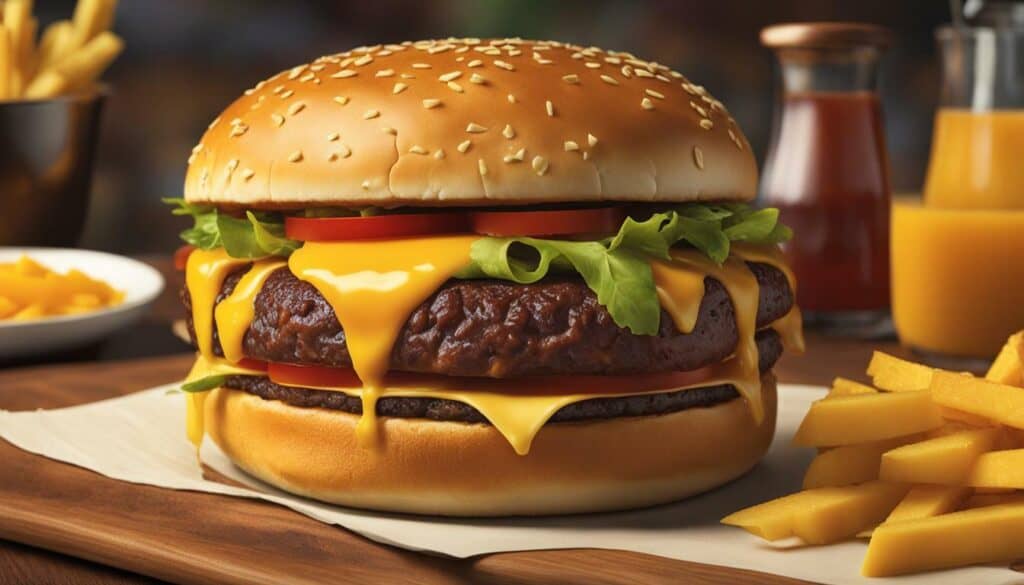
The image illustrates a mouthwatering cheeseburger with different cheese options. As you can see, the cheese adds a delicious layer of flavor to the burger, but it’s important to make mindful choices to keep your nutrition goals in check.
Creating a Healthier Cheeseburger
Want to enjoy a cheeseburger without compromising your health goals? Here are some simple tips for creating a healthier version.
1. Choose leaner meat: Opt for lean ground beef or turkey instead of higher fat options like regular ground beef. Leaner meats can help reduce the overall fat and calorie content of your cheeseburger.
2. Load up on veggies: Add a variety of fresh vegetables to your cheeseburger to increase its nutritional value. Consider toppings like lettuce, tomato, onion, and pickles for added crunch and flavor.
3. Swap the bun: Replace traditional white buns with whole wheat or whole-grain options. These buns are higher in fiber and provide more nutrients, making your cheeseburger a more balanced meal.
4. Mindful condiment choices: Be mindful of the condiments you use to dress your cheeseburger. Opt for lower-fat options like mustard or salsa instead of high-calorie mayonnaise or creamy dressings.
Table: Cheese Options and Their Impact on Nutrition
| Cheese Type | Calories (per slice) | Fat (grams) |
|---|---|---|
| American Cheese | 79 | 6.64 |
| Cheddar Cheese | 113 | 9.28 |
| Pepper Jack Cheese | 105 | 8.84 |
| Blue Cheese | 100 | 8.11 |
| Swiss Cheese | 106 | 8.37 |
| Brie Cheese | 95 | 7.86 |
| Part-Skim Mozzarella Cheese | 85 | 5.72 |
By making these simple adjustments, you can enjoy a delicious and healthier cheeseburger. Remember, moderation is key, and it’s important to savor your meal mindfully. Pair your cheeseburger with healthier side dish options like fresh fruit or a small salad to complete your balanced meal.

Homemade Cheeseburgers: A Nutritious Alternative
Making your own cheeseburgers can give you more control over the ingredients and allow you to make healthier choices without sacrificing flavor. By selecting leaner meats like turkey or grass-fed beef, you can reduce the fat content of your burger while still enjoying a juicy and satisfying meal. Ground chicken or plant-based alternatives are also great options for those looking to cut down on saturated fat.
When it comes to toppings, get creative with fresh and nutritious options. Load up on colorful vegetables like lettuce, tomato, and onion for added vitamins and minerals. You can also experiment with low-fat or Greek yogurt-based dressings as a healthier alternative to traditional mayonnaise-based sauces.
To further enhance the nutritional value of your homemade cheeseburger, consider using whole wheat buns or lettuce wraps instead of refined white bread. These alternatives provide more fiber and nutrients, helping you feel fuller for longer. And don’t forget to add a side of fresh fruit or a small salad instead of the usual fries or onion rings to keep your meal balanced and nutritious.
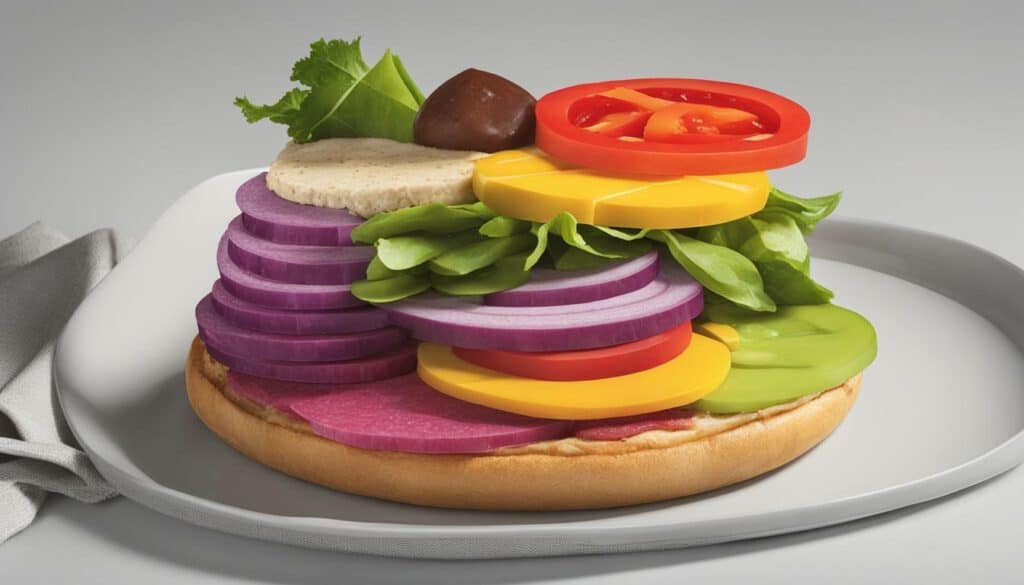
| Nutrition Facts | Amount per Serving |
|---|---|
| Calories | 350 |
| Fat | 14g |
| Sodium | 630mg |
| Carbohydrates | 35g |
| Fiber | 1.95g |
| Sugars | 6.01g |
| Protein | 17g |
By taking the time to create your own cheeseburgers, you can enjoy a nutritious alternative to restaurant offerings. With healthier meat options, smart toppings choices, and mindful sides, you can satisfy your cravings while maintaining a balanced diet. So, fire up the grill and get ready to bite into a delicious homemade cheeseburger!
Beware of Side Dish Pitfalls
While the focus is often on the cheeseburger itself, it’s important not to overlook the calorie impact of your chosen side dish. Sides like french fries and onion rings, although delicious, can add significant extra calories to your meal. For example, a medium-sized order of french fries typically contains around 365 calories and 17 grams of fat, while a serving of onion rings can have even more calories and fat.
These side dish pitfalls can quickly turn a relatively moderate-calorie cheeseburger meal into a high-calorie indulgence. It’s important to be mindful of your side dish choices and consider healthier alternatives that still complement your cheeseburger.
To help you make informed choices, here is a table comparing the calorie content of common side dishes:
| Side Dish | Calories | Fat (grams) |
|---|---|---|
| French Fries (medium) | 365 | 17 |
| Onion Rings (1 serving) | 450 | 24 |
| Side Salad (no dressing) | 50 | 0 |
| Fruit Cup | 60 | 0 |
As you can see, opting for a side salad or a fruit cup instead of french fries or onion rings can significantly reduce your calorie and fat intake while still adding some freshness and nutrition to your meal. These lighter options can help balance out the calorie content of your cheeseburger and support a healthier eating pattern.
Healthier Side Dish Alternatives
If you’re looking to balance out your meal, consider swapping out traditional high-calorie sides for healthier options. Instead of french fries or onion rings, which can add unnecessary calories and unhealthy fats, try incorporating fresh fruit or a small salad into your cheeseburger meal. Not only do these alternatives provide essential vitamins and minerals, but they also contribute to a more well-rounded and nutritious dining experience.
Fresh fruit, such as sliced apples, grapes, or berries, can add a burst of natural sweetness to your meal without the added sugars and unhealthy fats found in typical fried sides. They are also a great source of fiber, helping to keep you feeling satisfied and energized.
A small salad filled with leafy greens, colorful vegetables, and a light dressing can provide an extra dose of nutrients and contribute to your daily recommended servings of vegetables. Opt for a vinaigrette dressing or ask for it on the side to control the amount used. You can even add some protein, such as grilled chicken or tofu, for a more filling and balanced meal.
| Side Dish | Calories | Fat (g) | Sodium (mg) |
|---|---|---|---|
| French Fries (Medium) | 365 | 17 | 203 |
| Onion Rings (6 pieces) | 276 | 14 | 617 |
| Apple Slices (1 medium apple) | 95 | 0.3 | 0 |
| Side Salad (without dressing) | 25 | 0.3 | 22 |
By making these simple swaps, you can enjoy a delicious cheeseburger without sacrificing your health or your taste buds. Remember, small changes can make a big difference in creating a more balanced and nutritious meal.
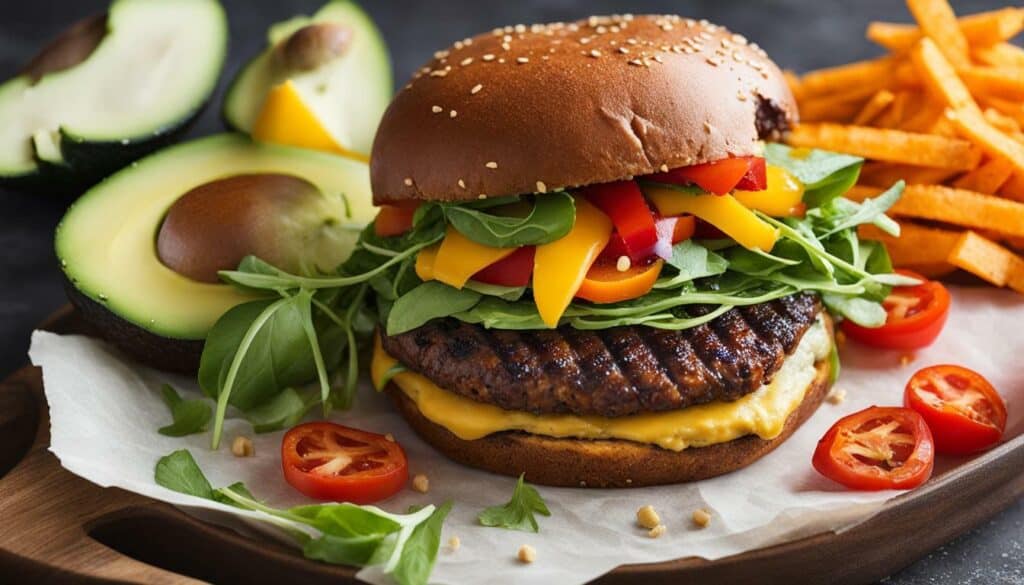
Enjoying a cheeseburger is all about balance and mindful eating. Here are some tips to help you fully appreciate your meal.
1. Take your time: Savor each bite and pay attention to the flavors and textures. Eating slowly allows your body to recognize when it’s full, preventing overeating. Remember, it’s not a race!
2. Mindful toppings: Choose your cheeseburger toppings wisely. Opt for fresh vegetables like lettuce, tomato, and onion for added nutrients and crunch. Skip the high-calorie sauces and try a flavorful mustard or a light mayo instead.
3. Pair it with a side salad: Instead of indulging in calorie-laden fries or onion rings, go for a side salad. It will provide additional fiber and nutrients, while still satisfying your craving for something crunchy.
4. Hydration is key: Enjoy your cheeseburger with a refreshing glass of water. This not only helps with digestion but also keeps you hydrated throughout your meal.
Remember, there’s no need to feel guilty about enjoying a cheeseburger. By being mindful of your choices and practicing portion control, you can savor every bite guilt-free. So go ahead, dig in!
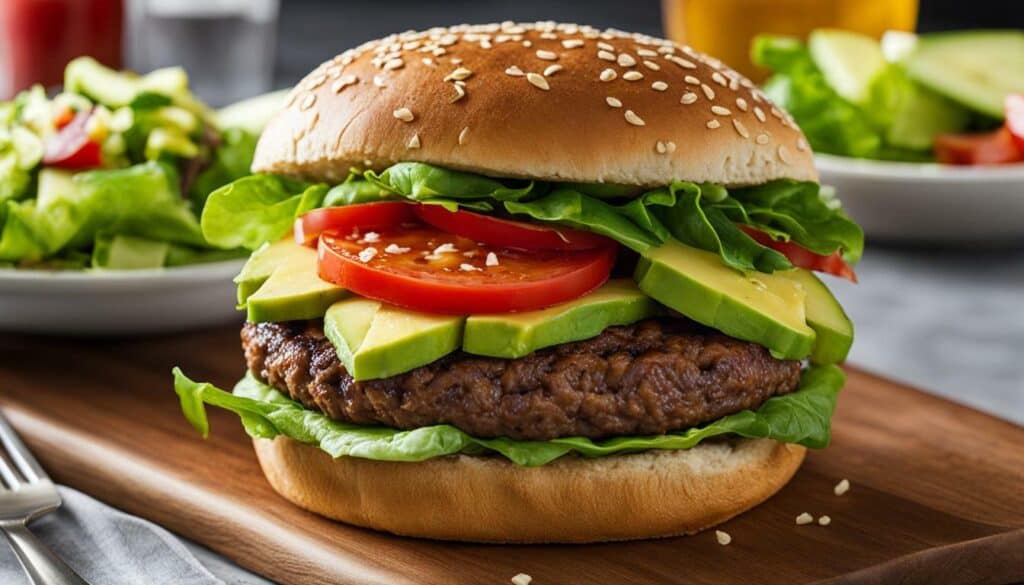
| Nutrient | Amount per Serving |
|---|---|
| Calories | 350 |
| Total Fat | 14g |
| Sodium | 630mg |
| Carbohydrates | 35g |
| Fiber | 1.95g |
| Sugars | 6.01g |
| Protein | 17g |
Dining Out Strategies for Healthier Choices
When dining out, there are simple steps you can take to make healthier choices without sacrificing flavor or enjoyment. Here are some strategies to keep in mind:
- Choose a leaner meat option for your cheeseburger. Opt for turkey or chicken patties instead of beef, as they are typically lower in fat and calories.
- Request a whole wheat or multi-grain bun instead of a traditional white bun. Whole grain options provide more fiber and nutrients.
- Load up on vegetables. Ask for extra lettuce, tomatoes, onions, and pickles to add freshness and crunch to your burger.
- Be mindful of condiments and sauces. Opt for mustard or salsa instead of mayonnaise or creamy dressings, which are often high in calories and fat.
- Choose a side dish wisely. Instead of french fries or onion rings, opt for a side salad with vinaigrette dressing or a steamed vegetable medley.
- Practice portion control. Consider sharing a burger with a friend or ordering a smaller-sized option to help manage your calorie intake.
- Don’t forget about hydration. Choose water or unsweetened iced tea instead of sugary sodas or milkshakes.
By following these strategies, you can make healthier choices while still enjoying a delicious cheeseburger. Remember, balance is key, and it’s okay to indulge occasionally. Making conscious decisions about what you eat can go a long way in maintaining a healthy lifestyle.
Table: Comparison of Cheese Options
| Cheese | Calories (per slice) | Total Fat (grams) | Saturated Fat (grams) |
|---|---|---|---|
| American Cheese | 70 | 6 | 3.5 |
| Cheddar Cheese | 113 | 9 | 6 |
| Pepper Jack Cheese | 105 | 9 | 5.5 |
| Blue Cheese | 100 | 8 | 5 |
| Swiss Cheese | 106 | 8.5 | 5 |
| Brie Cheese | 95 | 8 | 5.5 |
| Part-Skim Mozzarella Cheese | 85 | 6 | 3.5 |
Remember, the calorie and fat content of your cheeseburger will vary depending on the cheese you choose. Be mindful of the portion sizes and opt for lower-calorie options if you’re watching your intake.
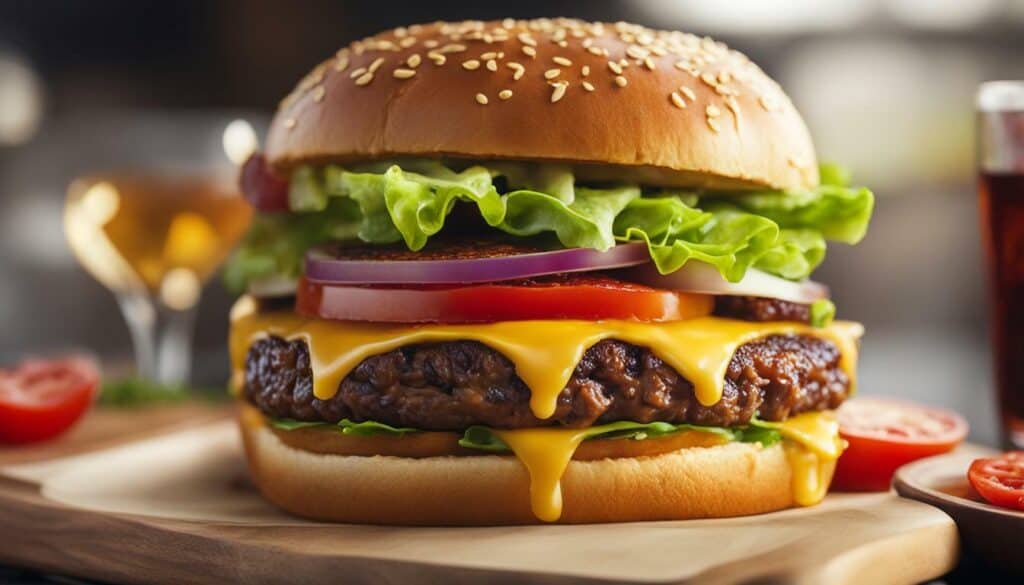
When dining out, it’s essential to make informed choices about what you eat. By following these strategies and being mindful of your selections, you can enjoy a tasty cheeseburger while still maintaining a balanced and nutritious diet.
Conclusion
By understanding the calorie content and making mindful choices, you can still savor the deliciousness of a cheeseburger while maintaining a balanced and healthy lifestyle.
A regular patty cheeseburger with bun typically contains around 350 calories, 14g of fat, 630mg of sodium, 35g of carbohydrates, 1.95g of fiber, 6.01g of sugars, and 17g of protein. However, it’s important to note that different restaurants and brands may have varying calorie counts and nutritional information for their cheeseburgers.
If you’re looking to reduce the fat, sodium, and calorie content of your cheeseburger, consider making it at home using leaner meat options such as turkey or chicken. Be mindful of the condiments and toppings you choose, opting for healthier alternatives like fresh vegetables and low-fat sauces.
When it comes to side dishes, popular options like french fries and onion rings can significantly increase the calorie count of your meal. Instead, try pairing your cheeseburger with healthier alternatives such as a side salad or fresh fruit.
Remember, enjoying a cheeseburger doesn’t mean you have to compromise on your health goals. With a little awareness and smart choices, you can still indulge in this classic favorite while maintaining a nutritious and balanced diet.
FAQ
Q: How many calories are in a regular patty cheeseburger with bun?
A: A regular patty cheeseburger with bun contains approximately 350 calories.
Q: How much fat does a regular patty cheeseburger with bun have?
A: A regular patty cheeseburger with bun contains 14g of fat.
Q: What is the sodium content of a regular patty cheeseburger with bun?
A: A regular patty cheeseburger with bun contains 630mg of sodium.
Q: How many carbohydrates are there in a regular patty cheeseburger with bun?
A: A regular patty cheeseburger with bun contains 35g of carbohydrates.
Q: Does a regular patty cheeseburger with bun have any fiber?
A: Yes, a regular patty cheeseburger with bun contains 1.95g of fiber.
Q: What is the sugar content in a regular patty cheeseburger with bun?
A: A regular patty cheeseburger with bun contains 6.01g of sugars.
Q: How much protein is in a regular patty cheeseburger with bun?
A: A regular patty cheeseburger with bun contains 17g of protein.
Q: How does adding cheese to a cheeseburger affect the nutrition?
A: Adding cheese to a cheeseburger increases the saturated fat content and the overall calorie count. Different types of cheese have varying calorie and fat counts.
Q: How can I make a healthier cheeseburger at home?
A: To make a healthier cheeseburger at home, you can use leaner meat, choose healthier condiments and toppings, and be mindful of portion sizes.
Q: Are side dishes like fries and onion rings high in calories?
A: Yes, side dishes like fries and onion rings can add additional calories to your meal. It’s best to opt for healthier alternatives like fresh fruit or a small salad.
Are Light Cream and Cheeseburger Comparable in Calorie Count?
When it comes to comparing calorie count, unveiling light cream’s calorie content and contrasting it with a cheeseburger can be eye-opening. While a typical cheeseburger’s calorie count can vary depending on ingredients, light cream tends to have considerably fewer calories. Thus, for those aiming for a calorie-conscious diet, choosing light cream over a cheeseburger can be a smart choice.

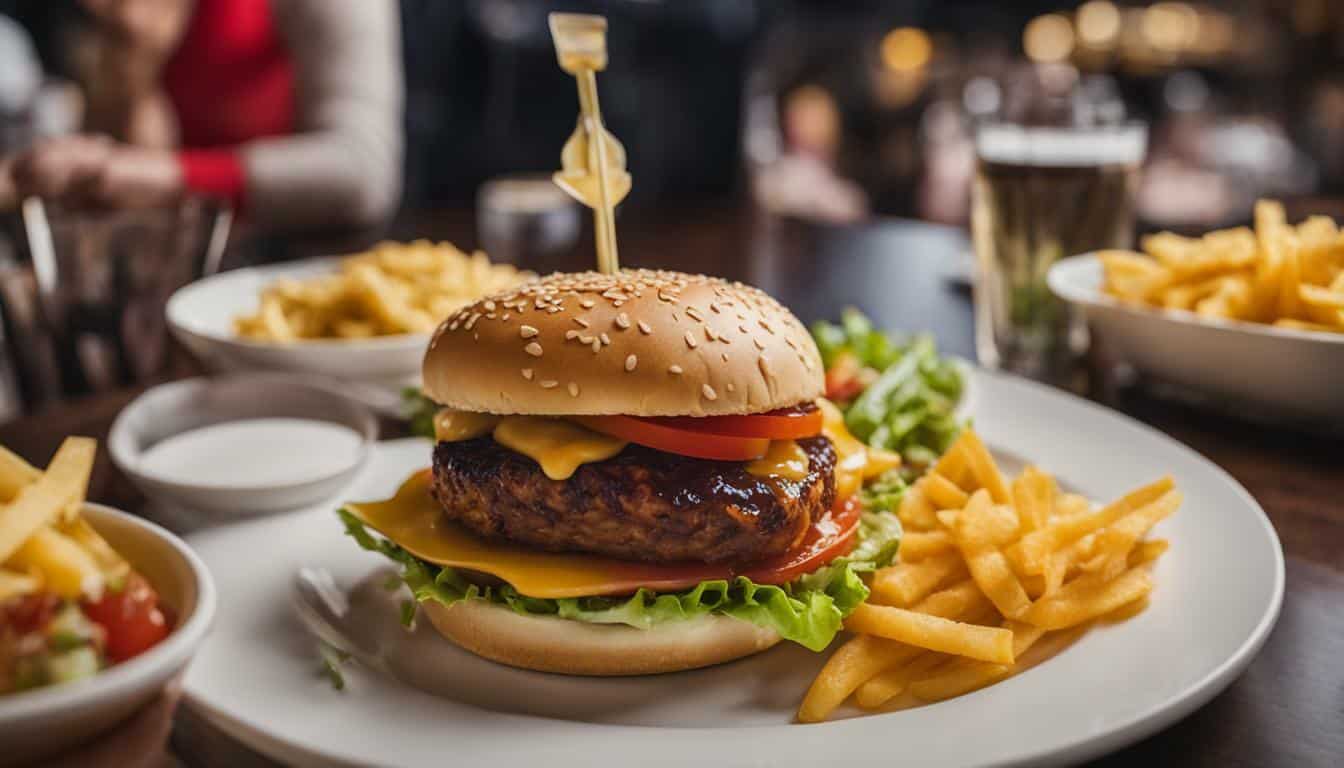



Leave a Reply